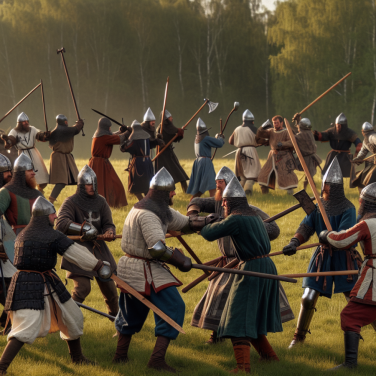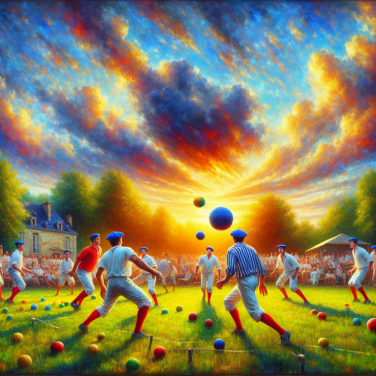Modern Revival and Current Popularity of Ballon au Poing in French Culture
Le Ballon au Poing, un jeu traditionnel qui trouve ses racines dans les provinces françaises, connaît aujourd'hui un renouveau fascinant. Longtemps cantonné aux archives de l'histoire et aux souvenirs des anciens, ce sport ancestral refait surface avec une vigueur surprenante au cœur de la culture française contemporaine.
Cet attrait renouvelé peut être attribué en partie à l'engouement général pour les activités qui offrent une échappatoire face à la mondialisation et à l'uniformité culturelle. Les individus se tournent de plus en plus vers des pratiques uniques et authentiques qui leur permettent de renouer avec leurs racines et de découvrir des aspects de leur identité culturelle parfois oubliés.
Le Ballon au Poing bénéficie particulièrement de ce phénomène. Les compétitions régionales en Picardie, où le jeu a historiquement été le plus populaire, ont vu leur fréquentation augmenter significativement. Les équipes, autrefois formées de joueurs issus de générations précédentes, sont désormais rajeunies grâce à l'intérêt croissant des jeunes enthousiastes désireux de préserver cet héritage.
Les festivals culturels et les événements sportifs locaux ont également adopté le Ballon au Poing comme élément central de célébrations, offrant aux habitants et aux touristes une expérience immersive dans la tradition française. Les médias sociaux jouent un rôle crucial dans cette résurgence en fournissant une plateforme pour partager des vidéos des matchs, des histoires captivantes liées au sport et des informations sur les événements à venir.
Les institutions éducatives se sont jointes à ce mouvement en intégrant le Ballon au Poing dans leur programme d'éducation physique, conscientes de l'importance de préserver ce sport non seulement pour sa valeur historique mais également pour son potentiel à promouvoir le travail d'équipe et la condition physique.
Le soutien de collectivités locales et d'associations pour la rénovation des terrains de jeu et la formation d'arbitres spécialisés témoigne d'un engagement communautaire fort.
Read also:
Exploring the Wonders of Earthball: A Globe-trotting Adventure
The Origins and Historical Significance of Ballon au Poing
Dating back to the 18th century, Ballon au Poing, which translates to "fist ball," holds a revered place among traditional French sports. It originated as a pastime in the Picardie region, and was especially popular among university students and the farming community. The sport showcases a rich historical panorama, where the physical prowess and strategic acumen of the players echo the societal valour and competitive spirit of bygone eras.
Rules and Gameplay: The Heart of the Excitement
Central to the thrilling experience of Ballon au Poing is a unique set of rules that dictate gameplay. Each team consists of six players, with positions ranging from the back to the front of the rectangular pitch. The ball, typically made of leather and filled with hair or straw for bounce, is struck with an open hand or fist – hence the sport's name. Players serve the ball from the backline, endeavoring to score by landing it in specific scoring zones and employing a combination of skill, strength, and strategy.
Ballon au Poing Today: A Cultural Touchstone
In contemporary France, Ballon au Poing continues to celebrate its rich heritage by holding annual championships and local tournaments, predominantly in its heartland of Picardie. These events are not mere athletic competitions; they are cultural festivals that bolster regional identity and historical appreciation. The game, played by men and women alike, has become emblematic of traditional French sportsmanship.
The Athletic Demands: An Intense Physical Challenge
Ballon au Poing is revered for the rigorous physical demands it places on its players. The sport requires not only exceptional physical strength and agility but also split-second tactical decision-making. The thrill of the game often lies in the powerful serves and volleys, where the athleticism of the players is on full display as they leap and dive to keep the ball airborne.
Preserving Tradition: The Role of Clubs and Societies
Numerous clubs and societies are dedicated to the preservation and promotion of Ballon au Poing. Through their efforts, the sport maintains its vitality and relevance among younger generations who are introduced to the game through school programs and junior leagues. These organizations are crucial for maintaining the infusion of fresh enthusiasm and talent into this age-old sport.
Global Appeal: Spreading the Excitement Beyond France
While intrinsically French, Ballon au Poing has begun to make inroads into other cultures.
Exploring the Historical Roots of Ballon au Poing: France's Unique Sporting Heritage
Ballon au poing is a fascinating and enduring piece of France's cultural and athletic tapestry, tracing its roots back to a time when such activities were not merely sports, but vital components of community bonding and regional identity. The game, whose name translates to "fistball," is believed to have originated in the picturesque Picardy region of northern France during the Middle Ages, a period when numerous ball games were popular across Europe.
The sport is thought to have evolved from rudimentary games played by peasants as a form of leisure and exercise, using whatever materials were at hand. It gradually became more structured, with established rules and designated playing areas. Ballon au poing was not just a casual pastime; it also played a significant role in social events like fairs and festivals, thereby cementing its place in the culture of the region.
During the 18th and 19th centuries, the game’s popularity grew as it became more organized and competitive. Rules were standardized, and the first known official set of rules was codified in the 1920s, leading to more formalized competitions. Players known as "balleurs" were revered and celebrated for their skills and athleticism, much like top athletes today. It's important to note that ballon au poing was, at first, primarily a game for men. Over time, women also began to participate, although they often played in separate leagues and events.
Another aspect of the game’s historical significance is its ability to survive and stay relevant. The world wars in the 20th century put a temporary halt to many sporting events throughout Europe, but ballon au poing made a spirited comeback, particularly after World War II, showcasing the resilience of the sport and its capacity to bring communities together in the face of adversity.
Today, the game is celebrated not only for its competitive nature but also for its historical and cultural importance. It embodies a connection to the past that is nurtured by tournaments, clubs, and educational outreach programs. Efforts are made to keep the tradition alive, primarily in Picardy, where local schools sometimes teach the game as a part of physical education, and summer tournaments attract both locals and tourists to witness this unique sport.




